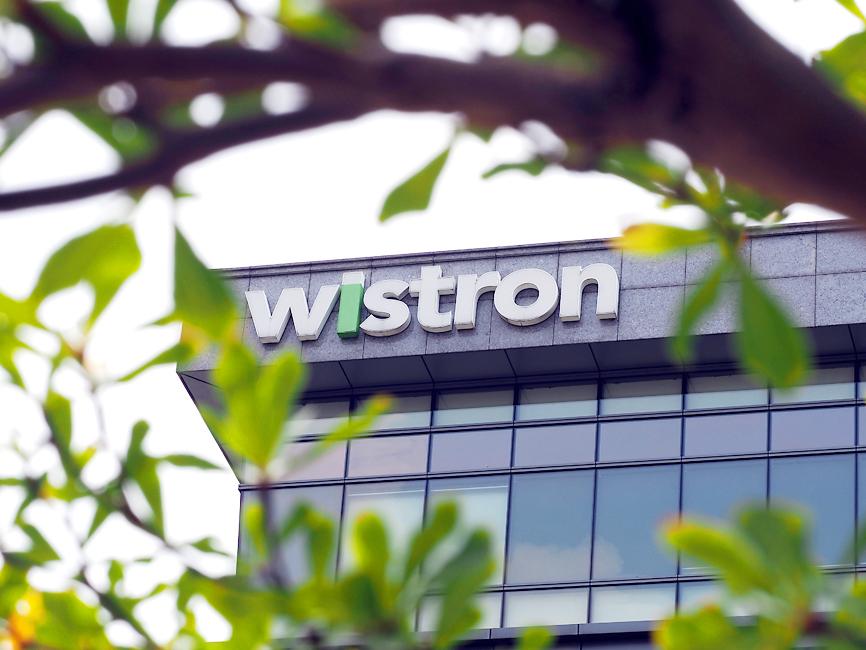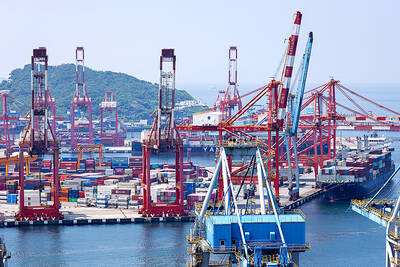Wistron Corp’s (緯創) board of directors has agreed to expand the company’s server production capacity at home and abroad, as well as sell its mobile phone business in China’s Kunshan in January, the company said last week.
The contract electronics maker — whose products include handsets, servers, laptops, PCs, tablets, video game consoles and LCD modules — has been expanding its non-Chinese production capacity over the past year, including in Taiwan, India, Malaysia, Vietnam and even in Texas, amid US-China trade tensions and geopolitical uncertainties.
The company’s board on Thursday approved a proposal to invest US$28 million in Wistron InfoComm Technology (Texas) Corp to add server production capacity at its Mexican plant to support exports to the US, according to company regulatory filings.

Photo: David Chang, EPA-EFE
The board also agreed to lease a plant owned by solar module supplier United Renewable Energy Co (聯合再生能源) in Hsinchu County’s Hukou Township (湖口) for NT$13.02 million (US$451,347) per month as Wistron aims to expand its server assembly capacity in Taiwan, regulatory filings showed.
As for its handset business, the company has reached a deal with China’s Luxshare Group (立訊集團) to sell its Kunshan plant for 3.3 billion yuan (US$499.52 million) and the board on Thursday agreed to close the deal on Jan. 1, while increasing investment in India, the filings showed.
“Wistron will invest more resources in profitable businesses after the disposal of its handset segment,” Yuanta Securities Investment Consulting Co (元大投顧) analysts led by Harvey Kao (高啟瑋) said in a note on Friday. “As the company will lean more on its server business going forward, we expect the contribution from server sales to rise from 27 percent this year to more than 35 percent next year.”
Its server business would become a key sales driver for Wistron next year, as the company’s notebook computer and LCD module businesses are likely to see flat sales compared with this year, while the PC segment would likely see mild market share gains, driven by more order wins from US clients, Yuanta said.
Wistron on Thursday reported third-quarter net profit of NT$2.78 billion, up 61.67 percent from a year earlier, while earnings per share rose from NT$0.61 to NT$1.
Gross margin increased to 5.37 percent, from 5 percent, thanks to a favorable product mix and contribution from its cloud computing equipment subsidiary Wiwynn Corp (緯穎科技).
Foreign-exchange gains of NT$240 million from effective hedging also lent support to margin performance.
In the first three quarters, net profit totaled NT$6.36 billion, or earnings per share of NT$2.26, and gross margin came in at 5.38 percent, the company said.

Nvidia Corp chief executive officer Jensen Huang (黃仁勳) on Monday introduced the company’s latest supercomputer platform, featuring six new chips made by Taiwan Semiconductor Manufacturing Co (TSMC, 台積電), saying that it is now “in full production.” “If Vera Rubin is going to be in time for this year, it must be in production by now, and so, today I can tell you that Vera Rubin is in full production,” Huang said during his keynote speech at CES in Las Vegas. The rollout of six concurrent chips for Vera Rubin — the company’s next-generation artificial intelligence (AI) computing platform — marks a strategic

REVENUE PERFORMANCE: Cloud and network products, and electronic components saw strong increases, while smart consumer electronics and computing products fell Hon Hai Precision Industry Co (鴻海精密) yesterday posted 26.51 percent quarterly growth in revenue for last quarter to NT$2.6 trillion (US$82.44 billion), the strongest on record for the period and above expectations, but the company forecast a slight revenue dip this quarter due to seasonal factors. On an annual basis, revenue last quarter grew 22.07 percent, the company said. Analysts on average estimated about NT$2.4 trillion increase. Hon Hai, which assembles servers for Nvidia Corp and iPhones for Apple Inc, is expanding its capacity in the US, adding artificial intelligence (AI) server production in Wisconsin and Texas, where it operates established campuses. This

Garment maker Makalot Industrial Co (聚陽) yesterday reported lower-than-expected fourth-quarter revenue of NT$7.93 billion (US$251.44 million), down 9.48 percent from NT$8.76 billion a year earlier. On a quarterly basis, revenue fell 10.83 percent from NT$8.89 billion, company data showed. The figure was also lower than market expectations of NT$8.05 billion, according to data compiled by Yuanta Securities Investment and Consulting Co (元大投顧), which had projected NT$8.22 billion. Makalot’s revenue this quarter would likely increase by a mid-teens percentage as the industry is entering its high season, Yuanta said. Overall, Makalot’s revenue last year totaled NT$34.43 billion, down 3.08 percent from its record NT$35.52

PRECEDENTED TIMES: In news that surely does not shock, AI and tech exports drove a banner for exports last year as Taiwan’s economic growth experienced a flood tide Taiwan’s exports delivered a blockbuster finish to last year with last month’s shipments rising at the second-highest pace on record as demand for artificial intelligence (AI) hardware and advanced computing remained strong, the Ministry of Finance said yesterday. Exports surged 43.4 percent from a year earlier to US$62.48 billion last month, extending growth to 26 consecutive months. Imports climbed 14.9 percent to US$43.04 billion, the second-highest monthly level historically, resulting in a trade surplus of US$19.43 billion — more than double that of the year before. Department of Statistics Director-General Beatrice Tsai (蔡美娜) described the performance as “surprisingly outstanding,” forecasting export growth